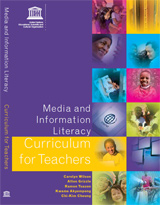UNESCO launched model Media and Information Literacy Curriculum for Teachers
05-07-2011 (Paris)

MIL Curriculum cover
© UNESCO
In a pioneering move to give impetus to media and information literacy (MIL) and civic participation, UNESCO has released a model Media and Information Literacy Curriculum for Teachers. This Curriculum is an important resource for Member States in their continuing work towards achieving the objectives of the Grünwald Declaration (1982), the Alexandria Declaration (2005) and the UNESCO Paris Agenda (2007) – all related to MIL.
This is part of the Organization’s underlying strategy to treat information literacy and media literacy as MIL and a combined set of competencies (knowledge, skills and attitude) necessary for citizens living in the 21st Century. According to Janis Karklins, Assistant Director-General for Communication and Information, the MIL Curriculum for Teachers is pioneering for the following reasons:
It is forward looking, drawing on present trends toward the convergence of radio, television, Internet, newspapers, books, digital archives and libraries into one platform – thereby, for the first time, presenting MIL in a holistic manner.
It is specifically designed with teachers in mind and for integration into the formal teacher education system thus ensuring a catalytic effect.
UNESCO believes this will enable its goal to increase drastically the number of media and information literate teachers worldwide who will in turn train students, thus leading to media and information literate societies. Therefore the starting point is to partner with UNESCO Member States and other stakeholders to adapt and integrate the MIL Curriculum into teacher training institutions globally.
The UNESCO MIL Curriculum is divided into two parts.
Part 1 provides the MIL Curriculum and Competency Framework, which gives an overview of the curriculum rationale, design, principal themes and the main competencies teachers should acquire through its use. It is complementary to the UNESCO ICT Competency Framework for Teachers (2008).
Part 2 includes the detailed Core and Non-Core Modules of the curriculum. On the whole, the MIL Curriculum mainstreams interdisciplinary issues relating to civic participation, problem-solving, gender equality and women’s empowerment and intercultural dialogue.
The publication is the product of a comprehensive process carried out over a three-year period. This process consisted of baseline surveys, expert group meetings, drafting, reviews and validation by experts from a wide range of domains such as media, information, ICTs, education and curriculum development.
The MIL Curriculum was launched during the First International Forum on Media and Information Literacy, the first of its kind at the international level to examine media and information literacy as a combined set of competencies. Over 200 participants representing all regions of the world, including educators, information and media experts, civil society actors and social scientists gathered to discuss MIL and share experience and knowledge. The participants adopted the Fez Declaration of MIL.
The preparation of the model MIL Curriculum for Teachers is a key aspect of UNESCO’s strategy to promote media and information literate societies. Other actions include: integration of MIL into all levels of education systems, particularly through:
adaptation of the MIL Curriculum for Teachers;
setting up of the MIL University Network;
facilitation of international cooperation;
preparation of a Global Framework on MIL Indicators;
development of Guidelines for Preparing National MIL Policies and Strategies;
establishment of an International Clearinghouse on MIL in cooperation with the United Nations Alliance of Civilizations; and
provision of Guidelines for electronic media on user-generated content and MIL.
UNESCO’s global action to promote media and information literate societies has at its basis the development of knowledge societies and free independent and pluralistic media, and information providers.
UNESCO believes this will enable its goal to increase drastically the number of media and information literate teachers worldwide who will in turn train students, thus leading to media and information literate societies. Therefore the starting point is to partner with UNESCO Member States and other stakeholders to adapt and integrate the MIL Curriculum into teacher training institutions globally.
The UNESCO MIL Curriculum is divided into two parts.
Part 1 provides the MIL Curriculum and Competency Framework, which gives an overview of the curriculum rationale, design, principal themes and the main competencies teachers should acquire through its use. It is complementary to the UNESCO ICT Competency Framework for Teachers (2008).
Part 2 includes the detailed Core and Non-Core Modules of the curriculum. On the whole, the MIL Curriculum mainstreams interdisciplinary issues relating to civic participation, problem-solving, gender equality and women’s empowerment and intercultural dialogue.
The publication is the product of a comprehensive process carried out over a three-year period. This process consisted of baseline surveys, expert group meetings, drafting, reviews and validation by experts from a wide range of domains such as media, information, ICTs, education and curriculum development.
The MIL Curriculum was launched during the First International Forum on Media and Information Literacy, the first of its kind at the international level to examine media and information literacy as a combined set of competencies. Over 200 participants representing all regions of the world, including educators, information and media experts, civil society actors and social scientists gathered to discuss MIL and share experience and knowledge. The participants adopted the Fez Declaration of MIL.
The preparation of the model MIL Curriculum for Teachers is a key aspect of UNESCO’s strategy to promote media and information literate societies. Other actions include: integration of MIL into all levels of education systems, particularly through:
UNESCO’s global action to promote media and information literate societies has at its basis the development of knowledge societies and free independent and pluralistic media, and information providers.
Related themes/countries
· Media and Information Literacy
Share this story:
Contact information
- UNESCO
Source














